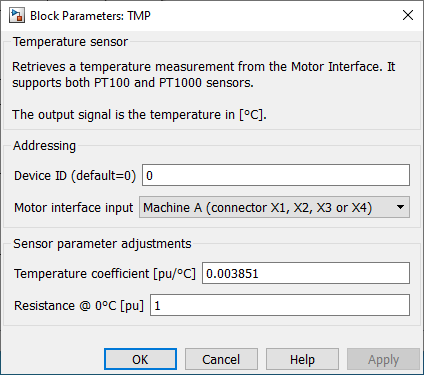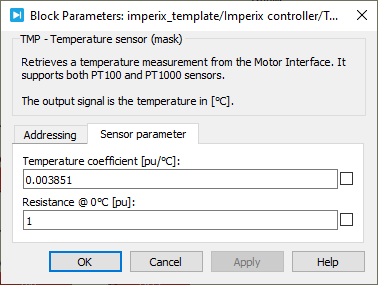Table of Contents
The temperature sensor (TMP) block provides access to the temperature measurement from a PT100 or PT1000 sensor for drive applications.
The B-Box RCP supports up to two temperature sensors through the Motor Interface for B-Box RCP. It can be either PT100 or PT1000 platinum resistors. These sensors have a standardized linear resistance-to-temperature characteristic (see the table below).
| Characteristic | PT100 | PT1000 | Unit |
| Nominal resistance @ 0°C | 100 | 1000 | Ω |
| Temperature sensitivity | 0.385 | 3.85 | Ω / °C |
The analog temperature measurement chain of the Motor Interface is agnostic to the type of resistor. Please refer to the datasheet on how to wire the sensors. As a result, the temperature sensor block does not require any knowledge of the sensor type, and parameters are normalized. The sensitivity of the sensors is 0.00385 pu/°C when normalized by the nominal resistance at 0°C. Similarly, the normalized offset is 1 pu.
Simulink block
Signal specification
- The output signal is the temperature in [°C].
- The
siminput signal is used in simulation and represents the actual temperature, computed by the simulation plant model. - The
>input signal needs to be connected to the sampling clock generated by the CONFIG block to account for the exact sampling instant in simulation.
Parameters
Device IDselects which B-Box/B-Board to address when used in a multi-device configuration.Motor Interface inputselects which connector of the Motor Interface is used as an input.Temperature coefficient [pu/°C]defines the sensitivity of the platinum resistor, normalized in per unit.Resistance @ 0°C [pu]defines the value of the platinum resistor at 0°C, normalized in per unit.
PLECS block
Signal specification
- The output signal is the temperature in [°C].
- The
siminput signal is used in simulation and represents the actual temperature, computed by the simulation plant model. - The
>input signal needs to be connected to the sampling clock generated by the CONFIG block to account for the exact sampling instant in simulation.
Parameters
Device IDselects which B-Box/B-Board to address when used in a multi-device configuration.Motor Interface inputselects which connector of the Motor Interface is used as an input.Temperature coefficient [pu/°C]defines the sensitivity of the platinum resistor, normalized in per unit.Resistance @ 0°C [pu]defines the value of the platinum resistor at 0°C, normalized in per unit.







